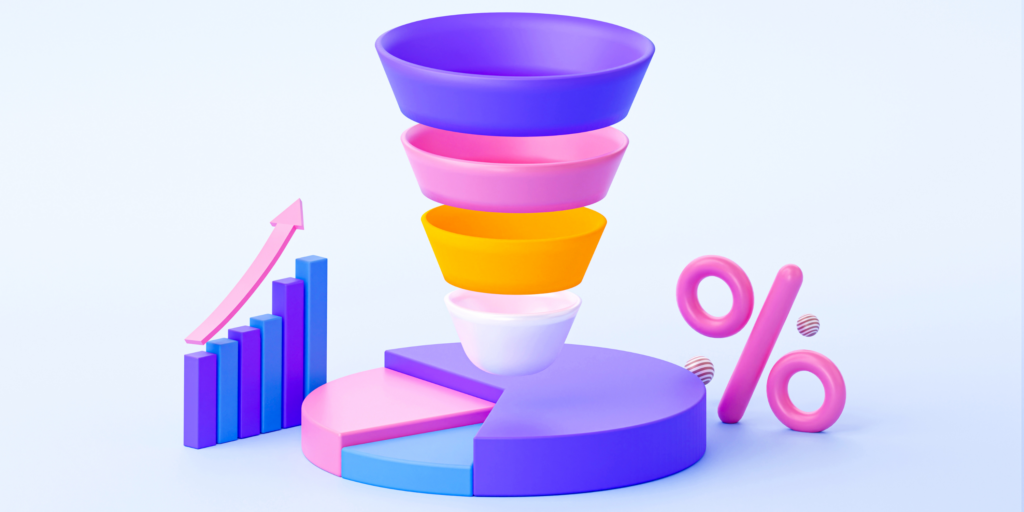
Scaling a business is no easy feat. While many businesses focus on boosting sales, true growth requires a disciplined approach that guides potential customers through each stage of their journey.
This is when scaling with the marketing funnel comes into play. A well-optimized marketing funnel recruits new leads, nurtures them, transforms them into paying customers, and keeps them for long-term value.
In this tutorial, we’ll examine how firms can use the marketing funnel to scale effectively, achieve sustainable growth, and maximize return on investment (ROI).
Understanding The Marketing Funnel
The marketing funnel depicts the client’s path from awareness to purchase (and beyond). While there are many variations, a standard marketing funnel consists of three major stages:
- Top of the Funnel (ToFu): Awareness and Attraction
- Middle of the Funnel (MoFu) Engagement and Consideration
- Bottom of the Funnel (BoFu): Conversion and Retention
To effectively scale, organizations must optimize each of these stages, ensuring a smooth transition from lead generation to long-term client loyalty.
Top of the Funnel (ToFu): Targeting the Right Audience
The top of the funnel focuses on increasing awareness and attracting new consumers. At this point, individuals may be unfamiliar with your brand or the solutions you provide. Your goal is to get their attention and develop interest.
Strategies for Scaling Tofu:
- Content Marketing: Create SEO-optimized blog entries, videos, and guides that address prevalent industry pain points.
- Paid Advertising: Create brand awareness campaigns with Google Ads, Meta Ads, and LinkedIn Ads.
- Social Media Marketing: Use networks such as Instagram, Twitter, LinkedIn, and TikTok to engage your target audience.
- Collaborate with influencers and industry experts to reach a larger audience.
- SEO and Organic Search: Optimize your website for search engines to increase organic traffic.
Key metrics to track include website traffic, social media engagement, brand mentions, ad impressions, and bounce rate.
Middle of the funnel (MoFu): Engaging and Nurturing Leads.
Once potential clients are aware of your brand, the next stage is to nurture them by giving value and establishing trust. They are considering their options, and you want to promote your company as the best choice.
Strategies to Scale MoFu
Lead Magnets and Gated Content: Provide valuable materials, such as eBooks, whitepapers, and case studies, in exchange for contact information.
- Email Marketing and Drip Campaigns: Use tailored email sequences to educate and engage leads.
- Webinars and Live Demos: Organize informative webinars to share your knowledge and answer queries.
- Retargeting advertisements: Use Facebook, Google, and LinkedIn retargeting advertisements to lure people back to your website.
- Social proof and testimonials: Share customer success stories, case studies, and reviews to increase credibility.
Key metrics to track are lead conversion rate, email open and click-through rates, content engagement, and webinar attendance.
Bottom of the Funnel (BoFu): Converting Leads to Customers
Leads at the bottom of the funnel are almost ready to make a purchase decision. Your job is to remove any remaining impediments and guide them to conversion.
Strategies to Scale BoFu
- Personalized Offers and savings: Offer special deals, free trials, and limited-time savings.
- Sales Enablement Content: Provide extensive product comparisons, ROI calculators, and case studies.
- Live Chat and Customer Support: Provide immediate assistance to address last-minute objections.
- One-on-One Sales Calls: If necessary, organize consultations or demos to address unique customer requirements.
- Referral and loyalty programs offer rewards and incentives to encourage referrals and repeat purchases.
- Key metrics to track include conversion rate, customer acquisition cost (CAC), sales revenue, and return on ad spend (ROAS).

Beyond the Funnel: Retaining and Growing Customer Relationships
Scaling does not cease with the initial conversion. The most successful organizations prioritize client retention and lifetime value (LTV).
Post-purchase growth strategies
- Customer Onboarding and Education: Use tutorials and welcome emails to provide a seamless onboarding experience for customers.
- Customer Success Programs: Provide ongoing support via specialized account managers and customer success teams.
- Upselling and cross-selling: Offer more items or services to existing clients.
- Engagement and Community Building: Encourage brand loyalty through online communities, private groups, and VIP programs.
- Feedback and Continuous Improvement: Conduct consumer surveys and use the results to improve your services.
- Key metrics to track are customer lifetime value (LTV), churn rate, repeat purchase rate, and net promoter score.
Putting It All Together: A Scalable Growth Framework
Scaling with the marketing funnel necessitates a comprehensive strategy that optimizes each stage while providing a smooth consumer experience. Here’s a framework for success:
1. Align Marketing and Sales Teams.
Ensure that both teams have common goals and data openness.
Define clear handoff points for leads at various funnel phases.
2. Leverage Data and Automation
Use CRM systems (such as HubSpot and Salesforce) to track and segment leads.
Automate email marketing and retargeting campaigns to increase efficiency.
3. Continuously test and optimize.
Conduct A/B tests on landing sites, email marketing, and advertisements.
Use analytics to fine-tune your funnel depending on performance metrics.
4. Scale Winning Strategies.
Focus on high-performing channels.
To increase expansion, reinvest profits in proven marketing methods.
Scaling the marketing funnel entails more than just raising ad spending or getting more leads; it also entails creating a long-term, repeatable strategy that nurtures potential consumers at every stage. You may achieve predictable growth while keeping high conversion rates and excellent customer relationships by fine-tuning your strategies, harnessing data, and continuously optimizing.
Ready to leverage all the marketing tools available? Get started today with your free consultation.




